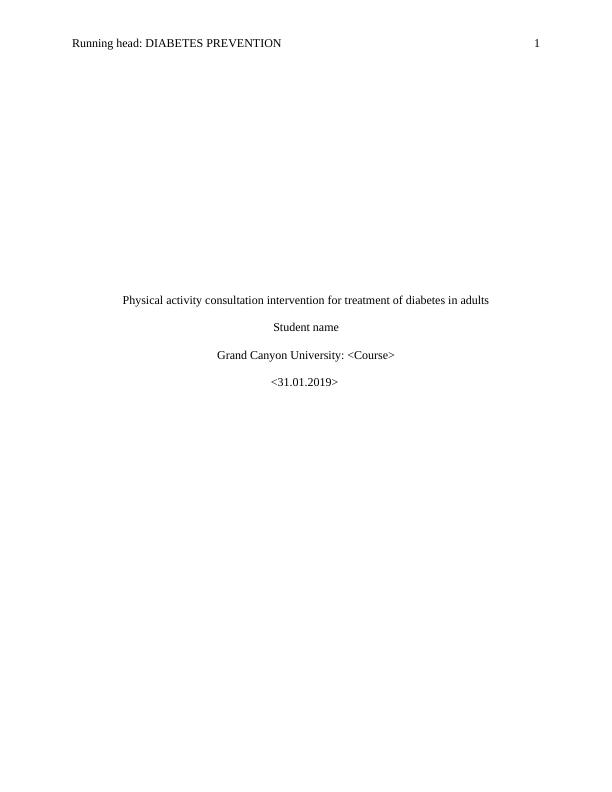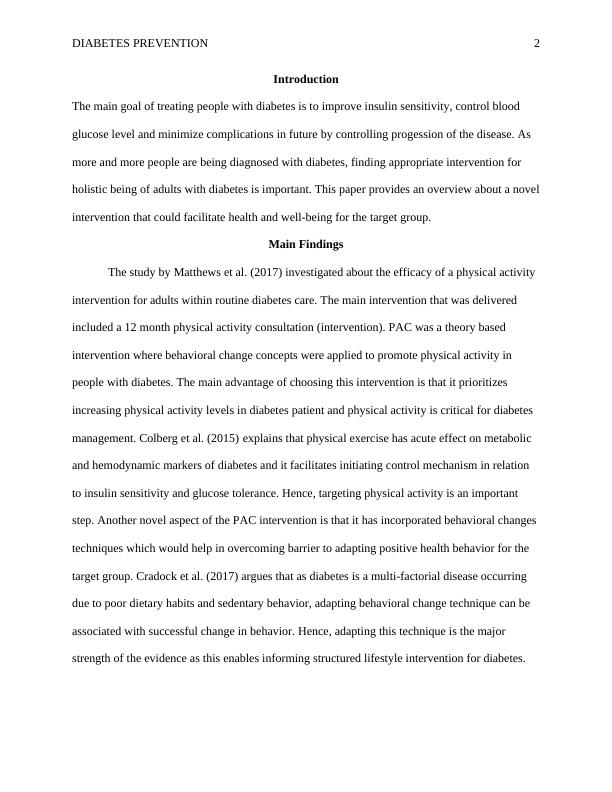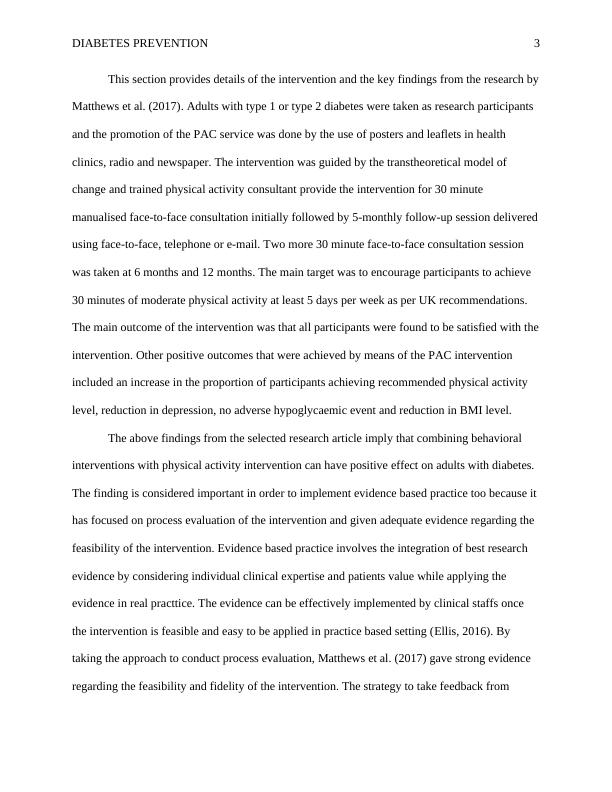Physical Activity Consultation Intervention for Treatment of Diabetes in Adults
Added on 2023-06-03
6 Pages1161 Words232 Views
Running head: DIABETES PREVENTION
Physical activity consultation intervention for treatment of diabetes in adults
Student name
Grand Canyon University: <Course>
<31.01.2019>
1
Physical activity consultation intervention for treatment of diabetes in adults
Student name
Grand Canyon University: <Course>
<31.01.2019>
1

DIABETES PREVENTION
Introduction
The main goal of treating people with diabetes is to improve insulin sensitivity, control blood
glucose level and minimize complications in future by controlling progession of the disease. As
more and more people are being diagnosed with diabetes, finding appropriate intervention for
holistic being of adults with diabetes is important. This paper provides an overview about a novel
intervention that could facilitate health and well-being for the target group.
Main Findings
The study by Matthews et al. (2017) investigated about the efficacy of a physical activity
intervention for adults within routine diabetes care. The main intervention that was delivered
included a 12 month physical activity consultation (intervention). PAC was a theory based
intervention where behavioral change concepts were applied to promote physical activity in
people with diabetes. The main advantage of choosing this intervention is that it prioritizes
increasing physical activity levels in diabetes patient and physical activity is critical for diabetes
management. Colberg et al. (2015) explains that physical exercise has acute effect on metabolic
and hemodynamic markers of diabetes and it facilitates initiating control mechanism in relation
to insulin sensitivity and glucose tolerance. Hence, targeting physical activity is an important
step. Another novel aspect of the PAC intervention is that it has incorporated behavioral changes
techniques which would help in overcoming barrier to adapting positive health behavior for the
target group. Cradock et al. (2017) argues that as diabetes is a multi-factorial disease occurring
due to poor dietary habits and sedentary behavior, adapting behavioral change technique can be
associated with successful change in behavior. Hence, adapting this technique is the major
strength of the evidence as this enables informing structured lifestyle intervention for diabetes.
2
Introduction
The main goal of treating people with diabetes is to improve insulin sensitivity, control blood
glucose level and minimize complications in future by controlling progession of the disease. As
more and more people are being diagnosed with diabetes, finding appropriate intervention for
holistic being of adults with diabetes is important. This paper provides an overview about a novel
intervention that could facilitate health and well-being for the target group.
Main Findings
The study by Matthews et al. (2017) investigated about the efficacy of a physical activity
intervention for adults within routine diabetes care. The main intervention that was delivered
included a 12 month physical activity consultation (intervention). PAC was a theory based
intervention where behavioral change concepts were applied to promote physical activity in
people with diabetes. The main advantage of choosing this intervention is that it prioritizes
increasing physical activity levels in diabetes patient and physical activity is critical for diabetes
management. Colberg et al. (2015) explains that physical exercise has acute effect on metabolic
and hemodynamic markers of diabetes and it facilitates initiating control mechanism in relation
to insulin sensitivity and glucose tolerance. Hence, targeting physical activity is an important
step. Another novel aspect of the PAC intervention is that it has incorporated behavioral changes
techniques which would help in overcoming barrier to adapting positive health behavior for the
target group. Cradock et al. (2017) argues that as diabetes is a multi-factorial disease occurring
due to poor dietary habits and sedentary behavior, adapting behavioral change technique can be
associated with successful change in behavior. Hence, adapting this technique is the major
strength of the evidence as this enables informing structured lifestyle intervention for diabetes.
2

DIABETES PREVENTION
This section provides details of the intervention and the key findings from the research by
Matthews et al. (2017). Adults with type 1 or type 2 diabetes were taken as research participants
and the promotion of the PAC service was done by the use of posters and leaflets in health
clinics, radio and newspaper. The intervention was guided by the transtheoretical model of
change and trained physical activity consultant provide the intervention for 30 minute
manualised face-to-face consultation initially followed by 5-monthly follow-up session delivered
using face-to-face, telephone or e-mail. Two more 30 minute face-to-face consultation session
was taken at 6 months and 12 months. The main target was to encourage participants to achieve
30 minutes of moderate physical activity at least 5 days per week as per UK recommendations.
The main outcome of the intervention was that all participants were found to be satisfied with the
intervention. Other positive outcomes that were achieved by means of the PAC intervention
included an increase in the proportion of participants achieving recommended physical activity
level, reduction in depression, no adverse hypoglycaemic event and reduction in BMI level.
The above findings from the selected research article imply that combining behavioral
interventions with physical activity intervention can have positive effect on adults with diabetes.
The finding is considered important in order to implement evidence based practice too because it
has focused on process evaluation of the intervention and given adequate evidence regarding the
feasibility of the intervention. Evidence based practice involves the integration of best research
evidence by considering individual clinical expertise and patients value while applying the
evidence in real practtice. The evidence can be effectively implemented by clinical staffs once
the intervention is feasible and easy to be applied in practice based setting (Ellis, 2016). By
taking the approach to conduct process evaluation, Matthews et al. (2017) gave strong evidence
regarding the feasibility and fidelity of the intervention. The strategy to take feedback from
3
This section provides details of the intervention and the key findings from the research by
Matthews et al. (2017). Adults with type 1 or type 2 diabetes were taken as research participants
and the promotion of the PAC service was done by the use of posters and leaflets in health
clinics, radio and newspaper. The intervention was guided by the transtheoretical model of
change and trained physical activity consultant provide the intervention for 30 minute
manualised face-to-face consultation initially followed by 5-monthly follow-up session delivered
using face-to-face, telephone or e-mail. Two more 30 minute face-to-face consultation session
was taken at 6 months and 12 months. The main target was to encourage participants to achieve
30 minutes of moderate physical activity at least 5 days per week as per UK recommendations.
The main outcome of the intervention was that all participants were found to be satisfied with the
intervention. Other positive outcomes that were achieved by means of the PAC intervention
included an increase in the proportion of participants achieving recommended physical activity
level, reduction in depression, no adverse hypoglycaemic event and reduction in BMI level.
The above findings from the selected research article imply that combining behavioral
interventions with physical activity intervention can have positive effect on adults with diabetes.
The finding is considered important in order to implement evidence based practice too because it
has focused on process evaluation of the intervention and given adequate evidence regarding the
feasibility of the intervention. Evidence based practice involves the integration of best research
evidence by considering individual clinical expertise and patients value while applying the
evidence in real practtice. The evidence can be effectively implemented by clinical staffs once
the intervention is feasible and easy to be applied in practice based setting (Ellis, 2016). By
taking the approach to conduct process evaluation, Matthews et al. (2017) gave strong evidence
regarding the feasibility and fidelity of the intervention. The strategy to take feedback from
3

End of preview
Want to access all the pages? Upload your documents or become a member.
Related Documents
Regular Exercise for Management of Type 2 Diabetes: A Scoping Reviewlg...
|2
|1263
|175
Principles of Primary Health Carelg...
|8
|1911
|235
Impact of Fat Diet in Prevention of Diabeteslg...
|16
|3833
|91
Diabetes Care | Proposal Part 1: Question and Literature Reviewlg...
|14
|2681
|14
Working with Communities: Strategies for Prevention and Management of Type 2 Diabeteslg...
|13
|2970
|445
Schizophrenialg...
|16
|4168
|125
